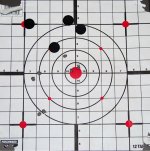I tried the Barnes TSX 25 cal., 115 gr flat base, in my .257 Weatherby today. I also had a new Zeiss 4.5-14 50 scope with Leupold rings on my previously-installed Leupold one-piece base.
Powder was 63.5 gr of H1000 and brass was once-fired Weatherby (Norma).
I think the only variables were the new scope, new rings and Barnes bullets.
I sighted in using some year-old reloads made up of the same brass and 117 gr Sierra GameKing bullets (63 gr of H4831). Adjustments to the scope were exactly as expected (4 clicks = 1 inch in any direction at 100 yds). Finally, I shot two 3-short groups with the Sierras at 50 yards (point of impact .5" high)
Then I moved to the Barnes at 100 yards.
The first bullet missed the target entirely. I shifted back to 50 yards and more or less hit the bullseye. Back to 100 yards - another miss. I'm scratching my head in dismay.
Finally, I came back to 50 yards and shot 6 of the Barnes and got a spread from 4" at 7:30 to 2" at 10:30. Clearly, the shot at 7:30 would have missed the 100 yard target.
There was a guy shooting next to me who was a gunsmith and he very kindly took a look at the gun/scope. He could find nothing wrong. He suggested that since the Barnes are sold copper, maybe they have to make them slightly smaller (sold copper not being able to "squeeze" down a barrel as easily as a lead-based bullet).
I just miked the two bullets (Barnes and Sierra). The difference is not measurable by my non-digital mike and tired eyes but after setting the mike on the Sierra, the Barnes IS slightly smaller. Not enough for me to mike the difference but enough to feel a wiggle.
Does anyone have any idea what could be happening?
Thanks
Powder was 63.5 gr of H1000 and brass was once-fired Weatherby (Norma).
I think the only variables were the new scope, new rings and Barnes bullets.
I sighted in using some year-old reloads made up of the same brass and 117 gr Sierra GameKing bullets (63 gr of H4831). Adjustments to the scope were exactly as expected (4 clicks = 1 inch in any direction at 100 yds). Finally, I shot two 3-short groups with the Sierras at 50 yards (point of impact .5" high)
Then I moved to the Barnes at 100 yards.
The first bullet missed the target entirely. I shifted back to 50 yards and more or less hit the bullseye. Back to 100 yards - another miss. I'm scratching my head in dismay.
Finally, I came back to 50 yards and shot 6 of the Barnes and got a spread from 4" at 7:30 to 2" at 10:30. Clearly, the shot at 7:30 would have missed the 100 yard target.
There was a guy shooting next to me who was a gunsmith and he very kindly took a look at the gun/scope. He could find nothing wrong. He suggested that since the Barnes are sold copper, maybe they have to make them slightly smaller (sold copper not being able to "squeeze" down a barrel as easily as a lead-based bullet).
I just miked the two bullets (Barnes and Sierra). The difference is not measurable by my non-digital mike and tired eyes but after setting the mike on the Sierra, the Barnes IS slightly smaller. Not enough for me to mike the difference but enough to feel a wiggle.
Does anyone have any idea what could be happening?
Thanks
Last edited:

